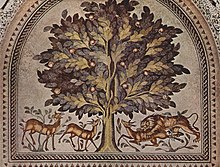User:James Flavio Ortiz/sandbox: Difference between revisions
m 1st draft of a new Section to the Wikipedia page Animals in Islam. The new section I am currently working on is titled Animals in Islamic art. |
brief change, will continue to edit |
||
| Line 1: | Line 1: | ||
== Animals in Islamic Art == |
== Animals in Islamic Art == |
||
The depiction of animals serve numerous functions in Islamic art. Various motifs of animals may work to serve as symbolic metaphors for human beings in many objects in the Islamic world of art but the use varies a great degree depending on the context.<ref>{{Cite web|url=https://login.libproxy.temple.edu/login?qurl=http://web.b.ebscohost.com%2fehost%2fpdfviewer%2fpdfviewer%3fvid%3d1%26sid%3d5b7d97ac-e4a5-4933-b648-400d136c2d22%40pdc-v-sessmgr02|title=Shibboleth Authentication Request|website=login.libproxy.temple.edu|access-date=2019-11-04}}</ref> Animals can serve as decorative motifs, examples of the depictions of animals being used for decorative purposes can be found in textiles, ceramics, metal work, mosaics, etc. throughout the Islamic world of art as well. There is also a plethora of different ways animals can be used for decorative purposes, including the fact that their use can tie back to the aforementioned symbolic aspect of things, e.g. to depict not an exact royal member of the Islamic society but rather royal tapestries In Islam used to cover furniture for example.** Lions for example when represented in textiles, have a representational link between them royalty, and royal furniture such as a throne. |
|||
[[File:Thr_muze_art_islam_4.jpg|thumb|Thr muze art islam 4]] |
[[File:Thr_muze_art_islam_4.jpg|thumb|Thr muze art islam 4]] |
||
The three past links show a tie in between all three. |
The three past links show a tie in between all three. |
||
Revision as of 01:56, 18 November 2019
Animals in Islamic Art
The depiction of animals serve numerous functions in Islamic art. Various motifs of animals may work to serve as symbolic metaphors for human beings in many objects in the Islamic world of art but the use varies a great degree depending on the context.[1] Animals can serve as decorative motifs, examples of the depictions of animals being used for decorative purposes can be found in textiles, ceramics, metal work, mosaics, etc. throughout the Islamic world of art as well. There is also a plethora of different ways animals can be used for decorative purposes, including the fact that their use can tie back to the aforementioned symbolic aspect of things, e.g. to depict not an exact royal member of the Islamic society but rather royal tapestries In Islam used to cover furniture for example.** Lions for example when represented in textiles, have a representational link between them royalty, and royal furniture such as a throne.

The three past links show a tie in between all three.
Many animals are often represented alongside vegetal patterns and are often found in an adorsed position (represented twice, symmetrically, and often side by side). In many instances we can find these adorsed or flanking animals surrounding a tree.

This example maybe an overarching motif depicting animals as representation for zodiac figures, symbols of power, and in the following image, another combination of all the former characteristics described: A lion (possible representation of an Islamic royal authority with power), taking down a deer (a rival power), around a tree (which could represent everything from a tree of knowledge, kingdoms, heavenly-cosmic power, the zodiac, etc.)[2]
Actual corporeal animals would sometimes be gifted to royal courts and the respective Sultans in power from other Islamic courts in the Islamic world. In many instances, these would be commemorated in paintings for example, this would be an artistic example serving the purpose of not only art but as historical documentation. In other Instances, we can observe acquired trophy pieces of animals such as tusks, being re-purposed, not only as a trophy but as a decoration. An Ivory casket for example could be gifted to a royal member and serve as a decorative piece, with various connotations behind it from a friendly gesture to a political warning.[3] Perhaps most interesting is that these caskets would be intricately carved from Ivory, and depict various animal motifs, in various relations to pleasure, power, etc. on a re-purposed piece of an animal. There is an odd “meta” self aware aspect to this artistic act.
The general over aching Idea of the examples that I have given, are that the use of animals as symbolic representations of humans, the zodiac, royal accoutrements, etc. were not necessarily exclusive in their use. Instead, they could cross the entire gamut in terms of art and culture, having multiple meanings and significance. The context could range from political, religious, decorative, to a combination of all three and then some.
References
 | This is a user sandbox of James Flavio Ortiz. You can use it for testing or practicing edits. This is not the sandbox where you should draft your assigned article for a dashboard.wikiedu.org course. To find the right sandbox for your assignment, visit your Dashboard course page and follow the Sandbox Draft link for your assigned article in the My Articles section. |
- ^ "Shibboleth Authentication Request". login.libproxy.temple.edu. Retrieved 2019-11-04.
- ^ Ahlwardt, Wilhelm, ed. (2009-12-31), "Arabischer Text", Sammlungen alter arabischer Dichter, Gorgias Press, pp. 123–314, ISBN 9781463215149, retrieved 2019-11-04
- ^ "Shibboleth Authentication Request". login.libproxy.temple.edu. Retrieved 2019-11-04.
